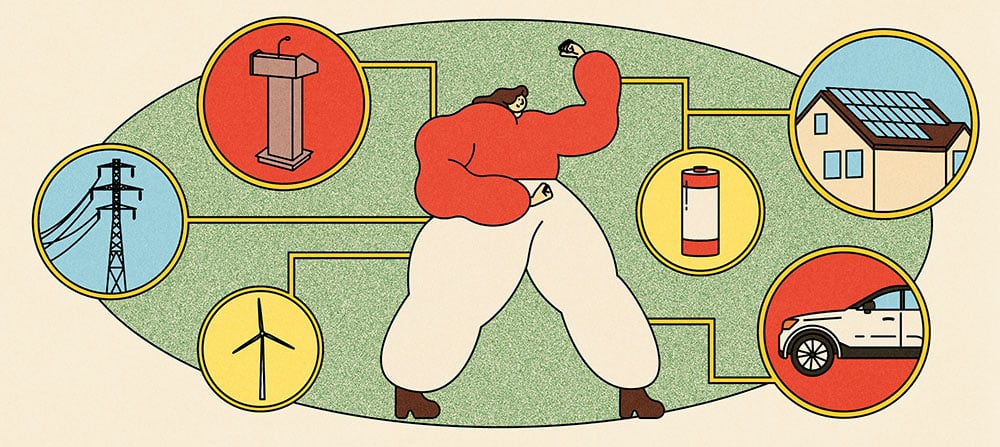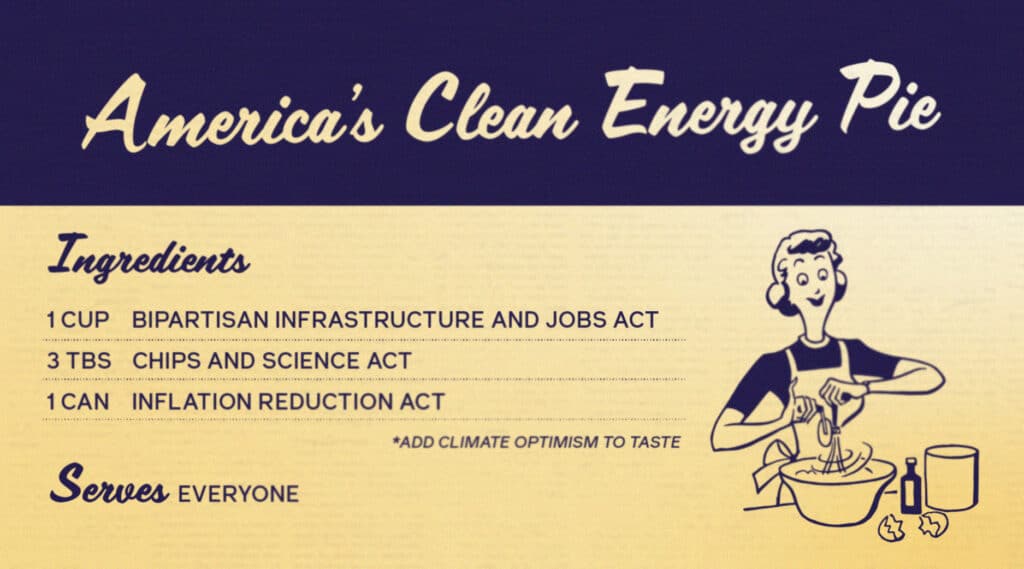Another international climate summit has wrapped up, and, like the others, it had a ton going on: delegates from nearly 200 countries, 100,000 activists, and lots of anticipation (maybe too much). (For a quick 101 on the world of climate talks and on COP26 in Glasgow, see our blog and this cheat sheet on key terms.)
The goal was to hammer out what countries will actually do, together, to combat climate change, with the aim of keeping the warming of the planet below 1.5 degrees Celsius, a target set in the 2015 Paris Agreement beneath which scientists say it is critical to stay.
While the transparency, cooperation, and peer pressure these climate summits enable are an important piece of the puzzle, we shouldn’t look to a gathering of national governments to save us. Things are moving and picking up speed—often out of the spotlight; these summits aren’t “at-bats” and we’re not “striking out”. Instead, David Roberts offers a deflationary take that is much more accurate and helpful:
“…National governments are often going to be in the caboose of this train — civic groups, the private sector, and subnational governments are leading the way. That’s distributed all over the world, less easy to see and sum up, but it shows that the caution and intransigence of national governments are not the whole story.”
COP26 was a snapshot of a world — agonizingly slowly but with gathering speed — moving to address a crisis. There’s no reason for anyone to stop pushing, but there’s also nothing wrong with acknowledging and celebrating the progress that’s been achieved by all the pushing so far.”
So here’s what went down at COP26 and what that means for you.
Progress made
Without question, COP26 was a major show of force. For two weeks straight, it topped news headlines, and the reporting was among the most comprehensive ever for this kind of event. As the biggest climate conference in history, with nearly 40,000 registered delegates, it forced the world’s attention on climate change and underscored the need to take action in this critical decade, not in some distant future. In the U.S. case, it attracted participants from all sides of the political spectrum (and they weren’t all necessarily knocking climate science), suggesting that momentum is building in the right direction.
A key goal in Glasgow was to finalize the Paris Agreement’s “rule book,” the nitty-gritty guidelines required to flesh out and strengthen the 2015 agreement. Not everyone was happy with the results, but the job got done (so we give it a “plus” for effort). The final Glasgow Pact calls on countries to beef up their climate targets annually (instead of every five years) and includes rules for implementing carbon markets, which enable countries to meet their climate targets in part by trading “credits” or offsets for emission cuts by others. The pact also calls for stronger technical assistance to help vulnerable (mostly poorer, developing) countries address climate-related “loss and damage” and renews a pledge of $100 billion annually in financing to help countries green their economies, shift to clean energy, and become more resilient to climate disaster.
Perhaps the most exciting outcome of COP26 was the inclusion of the “f-word”: fossil fuels. While this doesn’t seem like a huge milestone, the Glasgow pact was the first official summit text in 25+ years of climate talks to explicitly mention the need to curb fossil fuel use.
Outside the formal talks, notable pledges abounded: at least 105 countries agreed to slash emissions of methane (a potent greenhouse gas) 30 percent by the end of this decade; 130 countries vowed to halt deforestation by 2030 and to commit billions of dollars toward the effort; more than 40 countries agreed to phase out coal power in the coming decades; 6 automakers and 30 countries said they’ll phase out sales of gas- and diesel-powered cars and will work toward selling only zero-emissions vehicles by 2040; the U.S. and China issued a surprise joint statement that they’d do more to cut emissions this decade; and major financial institutions said they’d mobilize funding for clean energy.
In addition, several major countries, including India and Saudi Arabia, announced ambitious new targets to reach “net zero” emissions in the coming decades. This is a big deal, considering that until recently, net zero pledges covered only about 30 percent of the global economy, whereas now that share is close to 90 percent. Based on these outcomes, COP26 “has already helped summon more ambition to face this emergency than the world has ever seen,” noted U.S. climate envoy John Kerry. The International Energy Agency estimates that if countries actually follow through on their emission reduction pledges and long-term plans, the world could potentially limit warming to 1.8 degrees Celsius above preindustrial levels. This brings us much closer to “keeping 1.5 alive” than we were before.
What COP26 can’t do
Of course, this is all a big “if.” Everything outlined above is just a promise on paper, with little action so far and little accountability. Staying even within 1.8 degrees of warming assumes that countries like Australia, Brazil, and China will all meet their promises of reaching net zero emissions by around 2050, but concrete plans, policies, or funding to follow through are still lacking. National climate pledges are still considered too weak to avoid catastrophic warming, and most countries are on track to miss them. “The reality is you’ve got two different truths going on,” said Helen Mountford with the World Resources Institute. “We’ve made much more progress than we ever could’ve imagined a couple years ago. But it’s still nowhere near enough.” Without follow-up action, this and every other COP risks falling into the pit of youth activist Greta Thunberg’s three-word summary of the proceedings: “Blah, blah, blah.”
Many of the well-meaning pledges feature vague timelines and language, are rife with loopholes, and leave out major contributing countries or players. The fossil fuel industry also had a strong presence at the event (by one estimate, it represented a larger group than any single country). Although the Glasgow pact at least mentions fossil fuels, it does so while weakening the language on the need to reduce massive subsidies for coal, oil, and natural gas (estimated at $423 billion annually). The final text sneaks in what one critic termed “weasel words,” calling for the phase-down (not “phase-out”) of unabated coal power and of inefficient subsidies—all of which give countries an out for continuing destructive practices.
The climate summit also revealed the limitations of…well…climate summits—and of the international climate regime more broadly. For one, the Washington Post revealed that many countries actually underreport their greenhouse gas emissions in their submissions to the United Nations, which calls into question the whole effort to measure and track emissions, which relies on data accuracy. Decisions made at the COP must also be unanimous, with every participating country agreeing to the final wording of agreements, which inevitably leads to watered-down results. From an equity perspective, activists called COP26 “the most exclusive COP in history,” with the high cost of attending leading to a lack of global representation and a power imbalance in the negotiating rooms. The carbon footprint of the event itself was estimated to be double that of the previous COP (most of it coming from air travel).
COP26 offered the U.S. a chance to resume its global leadership. But it also revealed that the country may only be “back” to a limited extent, given the tough political climate back home. As one of the biggest contributors to global warming, the U.S. needs to drastically cut its emissions. But President Biden faces immense political and economic barriers. Although Congress was able to approve the recent $1.2 trillion infrastructure bill, which includes billions of dollars to help lessen the impacts of climate disasters, the funding and policies needed to actually cut U.S. emissions are still pending, including a $555 billion investment in incentives and programs to promote clean energy and electric vehicles (measures that could bring the U.S. about halfway to its goal of halving emissions by 2030).
The path forward
Ultimately, it’s unrealistic to think that a single conference can solve our climate challenges. A climate summit can establish common ground and help transform the mindset around the issue, but, as David Roberts aptly observed, “a COP agreement can’t make a country do anything.”
We can’t wait for a collection of more than 200 countries to collectively agree upon one set of rules, and then all follow them in unison. Think of the global climate solutions movement less of a finely tuned symphony in constant harmony, and more of an improv jazz ensemble with many players and instruments joining at different times and with different levels of influence; at times finding harmony, and other times forging their own path.
One of the criticisms of recent climate activism is that the pendulum has swung too far toward blaming “the system”, neglecting the role that individuals can play. Of course, some actions can only be taken by governments. But we need to take immediate steps at all levels: global, regional, national, local, and—yes—individual.
As individuals, we need to recognize the important influence we have—both in our personal lives and collectively—in shaping the future of the planet. Most of us understand what’s at stake: in polls, nearly 70 percent of U.S. adults say global warming is a serious problem. But so many Americans who are able to aren’t voting, talking, driving, and powering their homes like it.
We each have some combination of skills, resources, time, and energy to bring to the table—and a great first step is to find your role in the clean energy transition by visiting the CTA below. It’s time to get off the sidelines and get in the game.















